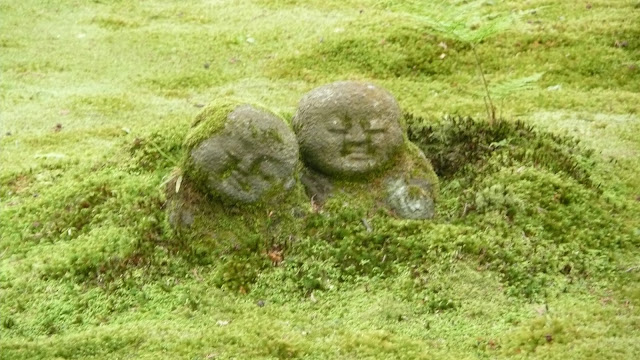Autumn in Otsu an hour east of Kyoto: Museums, Water, Ceramics and Maples
The city of
Otsu, at the foot of the mountains which line Lake Biwa's south shore, has long
been a major station on the trunk roads connecting eastern and western Japan.
Home to such historically significant places as Mii-dera Temple and Hiyoshi
Taisha Shrine, Otsu also has a wealth of interesting museums. The city is at
its very best in fall when the clear autumn skies are reflected in the deep
blue waters of Japan's largest lake. What better time to enjoy a stroll along
Otsu's Machinami Hakubutsukan Dori, or Exhibition Road. (Otsu is a
mere 30 minute drive from Kyoto. It can also be reached by taking JR's Tokaido
or Kosei Line, or Keihan Railway's Keishin Line.)
Setting off from
JR Otsu Station, the Tantan Bijutsukan, Japan's only haiku
museum, should be your first port of call. The famous haiku poet Matsuo
Basho was a great lover of Otsu, so it is appropriate that this city should
house this unusual museum. The focus is on illustrated haiku, and the curator,
Mr. Takeuchi Masayoshi, himself an accomplished poet, is more than willing to
answer questions about the exhibits. (Open 10 am to 5 pm, closed Saturdays.
The ¥800 admission fee includes a bowl of green tea and a sweet.)
Located in a
shopping arcade about a five-minute walk from the haiku museum is the Otsu
Matsuri Hikiyama Tenji-kan, one of the highlights of Exhibition
Road. This recently-opened museum featuring floats, mechanized puppets, videos,
and festival music, enables visitors to experience the famous Otsu Matsuri all
year round. (Open 10 am to 7 pm, closed Mondays. Admission free.)
If you have
children with you, you might consider stopping off at the toy museum known as Yuyukan,
situated about five minutes further down the arcade. The third floor houses a
collection of toys from around the world, and the second floor has a
well-equipped play room. (Open 10 am to 7 pm, closed Wednesdays. Admission
free.)
The Otsu
Historical Museum, about a fifteen-minute walk from the toy museum, is the
last venue on the museum trail. On the way you might like to drop into Takahashi
Shozan's shop and watch him producing the humorous, satirical paintings
native to Otsu, known as Otsu-e. These paintings, which initially
concentrated on Buddhist images, were originally sold as souvenirs to travelers
making their way along the old Tokaido Highway.
The Otsu
Historical Museum houses folk-craft items such as fishing nets and carpenter's
tools, as well as a collection of paintings and scrolls. Exquisitely-made scale
models (many of which have moving pieces) depict Otsu at different points in
its history and are a real aid to understanding. (Open 9 am to 4:30 pm,
closed November 2nd, 4th, 9th, 16th, and 24th. Admission ¥200. From the 1st to
the 29th, a special exhibition, "Nobunaga and Otsu", will focus on
the life of the famous warlord Oda Nobunaga.)
Just across from
the museum, surrounded by a moss-covered stone wall, is the beautiful temple of
Mii-dera, founded in the seventh century. Fascinating at any time of
year, this head temple of the Tendai Sect of Buddhism will be particularly
beautiful this month as the extensive tree-filled grounds will be ablaze with
the oranges, russets, and reds of autumn maples. (Open daily, 8 am to 5 pm.
Admission ¥450.)
No Autumn visit
to Otsu would be complete without a visit to the area of Sakamoto.
Particularly renowned for its fall scenery, Sakamoto is also well-known for its
satobo, about fifty small temples, many of which incorporate tranquil
tea gardens, to which monks from the Mount Hiei temple complex of Enryaku-ji
retire. The neighborhood is also known as monzencho — a district that
grew up outside the gates of a temple. Stop at one of these and revive yourself
with a bowl of green tea, or, if you are in need of more substantial
sustenance, drop in at one of the many shops in Sakamoto which specialize in
hand-made soba noodles.
It is in
Sakamoto, nestled at the foot of Mount Hiei, that Hiyoshi Taisha Shrine,
guardian of Enryaku-ji, is to be found. Said to be the oldest shrine in Japan,
Hiyoshi Taisha's history predates that of the Grand Shrine at Ise. It also has
the distinction of being home to the country's oldest stone bridge. The broad
maple-lined gravel approach should be particularly spectacular this month. From
5:30 to 9:30 pm on the 9th to 24th, the temple's maples will be illuminated in
a special ceremony. (Open daily, 8 am to 5 pm. Admission ¥200.)
Keihan Bus
offers sight-seeing bus tours of Otsu. The starting point is the Hachijo-guchi
exit of JR Kyoto Station. For more information call: (075) 672-2100. For information
about Bianca and Michigan, Lake Biwa's cruise boats, call: (0775) 24-5000.



Comments